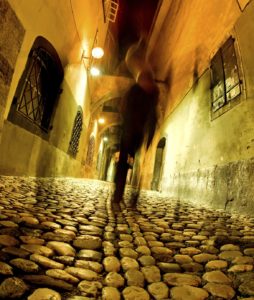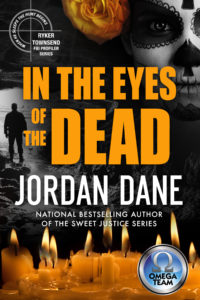My last critique for 2016. I’ve enjoyed reading the anonymous submissions this year. We have some very talented authors following our blog. Thanks to all of you who participate with your comments and for all those brave souls who have submitted your work for our feedback. We all learn from the experience.
Enjoy UNKNOWN RIDER and I’ll have my feedback on the flip side. Please provide constructive criticism in your comments. Thank you.
***
Prologue
A narrow palm-lined alley led off the main boulevard to the boat docks. A warm front had blanketed the area with a thick overcast, obliterating the faint starlight on the moonless night. At one o’clock in the morning, the few functioning streetlights created a dimly lit gloom that made it hard to distinguish between the living and the nonliving as the tropical breeze animated palm fronds and various pieces of trash on the derelict street. It was still a quarter of a mile to the docks, but even at this distance the low-tide smell of spilled diesel fuel, dead fish, and decay polluted the air.
Frank Stodd walked quickly down one side of the pavement towards the water. He looked very much out of place in his dark suit and tie, but he hadn’t planned to be here. He had a growing suspicion that he had taken a wrong turn on the way back to the hotel, but he pressed on, looking over his shoulder every few seconds for the black Escalade. Then he patted the gun through his jacket for reassurance, and felt for the small package in his inside coat pocket. He was a large man, quite overweight, and in spite of the sea breeze blowing in towards the shore, he was sweating profusely underneath the stiff white collar of his shirt.
Maybe he could see the hotel when he got to the water at the end of the alley, he told himself. It was a well-lit high rise, after all, with a big red ‘Hilton’ on the side. There was too much at stake to blow it now.
They had seen him in the van outside the bar in old San Juan. He’d sped off immediately, cursing his bad luck, but they tailed him for several blocks. Finally, he lost them somewhere near his hotel, ditched the van, and continued on foot. The shortcut he’d taken past the marina and docks should have thrown them off. Yes, he was sure now that he’d lost them.
But against the wall of a building, well hidden in the shadows to Stodd’s left, was another man. In blue jeans and a t-shirt, he looked like anyone else you might see in the city, someone who had bubbled out of the melting pot of the Caribbean. He checked the cylinder of his revolver to confirm that it was fully loaded and wondered again whether the silencer screwed into the end of the barrel might affect the gun’s accuracy. But when he got a good look at the size of his target he decided it wouldn’t matter.
He raised the gun at arm’s length.
Stodd saw a flash from his left. There was a slight whooshing sound like someone had spit, the sledgehammer impact of the bullet, then he was lying on his side, his left arm and shoulder on fire. The pavement was cool in spite of the heat of the night, his vision blurred, and the pain took a back seat. He knew only that he was tired and wanted to rest. He closed his eyes.
FEEDBACK:
OVERVIEW – There are some gems in this intro. The author has a visual style and imagery is important. Often setting is overlooked, but not with this author. I like how he or she describes through use of the senses too. I can see Frank sweating as he lumbers through a shady part of town. But there is an issue with ORDER in this scene. The idea is to introduce a conflict and tension and build upon it, not deflate it. Below are some observations:
SETTING – The first paragraph is an author’s chance at establishing a voice. In this example, the author describes weather and setting without these elements being through any character. As much as I can appreciate a good setting, without a character seeing it, I tend to skim. I don’t even know where the description is supposed to be, other than it’s coastal and has palm trees and water. By mentioning San Juan and Caribbean much later, this appears to be Puerto Rico. Why not include a tag line to establish the location right away? That would make the setting an instant recognition for the reader and even establish a time of day. It’s best not to make the reader guess or have to reread because they thought the setting was somewhere else, like Florida.
REVISED START – I would consider starting with elements of paragraph 2. I like knowing Frank is out of place and uncomfortable where he’s walking. It makes me wonder what he’s up to, but make him sweat for more than weather. The example below is a rough draft and if it were mine I’d tweak it more, but I hope you get the idea. Getting into Frank’s head and the tension he’s feeling is the place to start.
Example – Frank Stodd picked up his pace as he walked toward the docks, looking out of place dressed in his dark suit and tie. He tugged at his stiff white collar with sweat trickling through his hair. Muggy heat turned the stench of low-tide into a vile smell of spilled diesel fuel, dead fish, and decay. He must’ve taken a wrong turn on his way back from the hotel and he kept glancing over his shoulder for the black Escalade. The small package he carried in his jacket pocket weighed heavy, pressed against his gun.
PUT YOUR SETTING TO WORK – Rather than start with a long first paragraph to establish setting, the author might consider peppering the heat and the stench and other sensory descriptions to add to Frank’s discomfort and tension. Make the setting work by using it to escalate the tension or messing with Frank’s head. I’ve incorporated some of the setting descriptions into the revised intro to exacerbate Frank’s situation and add tension. He’s a heavy man and he’s sweating, not only because of weather and where he is. He’s anxious over his situation, so an author can drop in setting through action to enhance the intended emotion for the scene, without slowing the pace.
USE of PROLOGUE – I’ve never had an editor say they wouldn’t buy something because it had a Prologue, but when you get authors together and they talk about perceived rules, they usually are not in favor of using Prologues. If a Prologue is used properly, where the inciting incident of a story begins earlier (ie Batman as a boy when he witnesses his parents murdered before he dedicates his life to fighting crime), then make it clear it’s a short segment that is the foundation for what comes. Lately, I’ve simply started on Chapter 1, even if there is an older inciting incident, because I use tag lines to establish the time and place. But I wanted to point it out, as I’m sure others might comment. I’m indifferent, but a Prologue should be used in the right way.
STICK WITH THE ACTION – Once a story has started with action, it should stick to that action and not vacillate from what’s happening to drift away from it. The idea is to BUILD on tension and not deflate it. In the short paragraph that starts with “Maybe he could see the hotel…” – this deflates the tension established when the reader sees Frank is in trouble. He thinks of getting back to his hotel and even the line of “not blowing it now” is ‘telling’ and could be deleted to stick with the action of him being tailed.
ACTION OUT OF ORDER – The action in this opener is out of order. The author should resolve this to not lose any momentum in the action from start to finish.
“They had seen him in the van…” This is a 4th paragraph flashback to an earlier incident the same evening. The author could consider starting at that point where Frank is spotted by shady characters or by men in the Escalade and he tries to outrun them in his overweight condition, not dressed for the occasion. Or have Frank evading the Escalade and stick with the action to have the vehicle find him again. No need to go back. No matter which way the author decides, the action should gain momentum and tension should be mounted and not diffused.
KNOW YOUR WEAPON – Another point I would like to make with regard to action – once guns are drawn, there’s no time for checking for bullets in a revolver. Frank was nervous enough to pat down his pocket to make sure he had his gun. He should know if it’s loaded. I’m also a believer in adding details like the type of revolver. Most gun enthusiasts know what they are carrying. It looks novice if the author ignores the details. I’m also thinking guys who ride around in Escalades, aren’t carrying revolvers. I’d be thinking of ramping up the firepower to a semi-auto.
A SUPPRESSOR ON A REVOLVER? – A revolver has a short barrel. Between the cylinder (bullets) and the forcing cone is the cylinder gap where the gases, flames, and sound escape when fired. VIDEO ON THE MYTH The way this intro is written, very generically, most crime fiction readers would question a suppressor on a revolver unless the author can research a type of gun like the Nagant M1895, a Russian revolver, where these gases are contained. Here’s a VIDEO of someone shooting a suppressed Nagant. Look at how large this weapon is (with suppressor) and how difficult it would be for Frank to have it under his jacket. I don’t see how a suppressor enhances this scene and it actually stands out as a research error. Plus if other people are shooting back, without suppressors, what’s the point of Frank being stealthy? I tend to think of suppressed weapons as in the hands of assassins or killers who are the aggressors. Frank seems to have the weapon for defense purposes.
POV – In the sentence below, the author brings in a shooter, but since the guy is “well hidden,” how can Frank see him? It would appear to be an omniscient POV as was the first paragraph where the setting is described without being in Frank’s head. I would strongly suggest one POV in this scene, through Frank’s eyes.
“But against the wall of a building, well hidden in the shadows to Stodd’s left, was another man.”
FRANK SHOT – Frank seems like he’s resting rather than shot at the end. I know in the heat of the moment, often gunshot wounds aren’t felt (except as a punch) when the adrenaline is high, but I would consider shortening the sentences and making him feel more than tired, just to add tension for the reader. He seems too calm.
DISCUSSION:
1.) What do you think, TKZers? Comments anyone? What do you like? What would you suggest to improve this intro?
In the Eyes of the Dead – $1.99 Ebook – Ryker Townsend FBI Profiler series
After four teens are murdered, a mysterious Santeria holy man and his devoted followers force Ryker and Athena to join forces to uncover a tragic truth.


